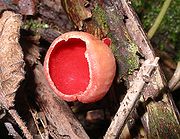.gif)
Sporocarp (fungi)
Encyclopedia
In fungi, the sporocarp (also known as fruiting body or fruit body) is a multicellular structure on which spore
-producing structures, such as basidia or asci
, are borne. The fruiting body is part of the sexual phase of a fungal life cycle
, with the rest of the life cycle being characterized by vegetative
mycelial
growth and asexual spore production.
The sporocarp of a basidiomycete is known as a basidiocarp
, while the fruiting body of an ascomycete is known as an ascocarp
. A significant range of different shapes and morphologies are found in both basidiocarps and ascocarps; these features play an important role in the identification and taxonomy of fungi.
 Fruiting bodies are termed epigeous if they grow on the ground, as with ordinary mushrooms, while others which grow underground are hypogeous. Epigeous sporocarps that are visible to the naked eye, especially fruiting bodies of a more or less agaricoid morphology, are often referred to as mushroom
Fruiting bodies are termed epigeous if they grow on the ground, as with ordinary mushrooms, while others which grow underground are hypogeous. Epigeous sporocarps that are visible to the naked eye, especially fruiting bodies of a more or less agaricoid morphology, are often referred to as mushroom
s, while hypogeous fungi are usually called truffles or false truffle
s. During their evolution truffles lost the ability to disperse their spores via air currents, instead propagating by animal consumption and subsequent dispersal of their spores.
In amateur mushroom hunting
, and to a large degree in academic mycology
as well, identification of higher fungi is based on the features of the sporocarp.
The largest known fruiting body is a specimen of Fomitiporia ellipsoidea
found on Hainan Island. It measures up to 1085 centimetres (427.2 in) in length and is estimated to weigh between 400 and 500 kg (881.8 and 1,102.3 lb).
Spore
In biology, a spore is a reproductive structure that is adapted for dispersal and surviving for extended periods of time in unfavorable conditions. Spores form part of the life cycles of many bacteria, plants, algae, fungi and some protozoa. According to scientist Dr...
-producing structures, such as basidia or asci
Ascus
An ascus is the sexual spore-bearing cell produced in ascomycete fungi. On average, asci normally contain eight ascospores, produced by a meiotic cell division followed, in most species, by a mitotic cell division. However, asci in some genera or species can number one , two, four, or multiples...
, are borne. The fruiting body is part of the sexual phase of a fungal life cycle
Biological life cycle
A life cycle is a period involving all different generations of a species succeeding each other through means of reproduction, whether through asexual reproduction or sexual reproduction...
, with the rest of the life cycle being characterized by vegetative
Vegetation
Vegetation is a general term for the plant life of a region; it refers to the ground cover provided by plants. It is a general term, without specific reference to particular taxa, life forms, structure, spatial extent, or any other specific botanical or geographic characteristics. It is broader...
mycelial
Mycelium
thumb|right|Fungal myceliaMycelium is the vegetative part of a fungus, consisting of a mass of branching, thread-like hyphae. The mass of hyphae is sometimes called shiro, especially within the fairy ring fungi. Fungal colonies composed of mycelia are found in soil and on or within many other...
growth and asexual spore production.
The sporocarp of a basidiomycete is known as a basidiocarp
Basidiocarp
In fungi, a basidiocarp, basidiome or basidioma , is the sporocarp of a basidiomycete, the multicellular structure on which the spore-producing hymenium is borne. Basidiocarps are characteristic of the hymenomycetes; rusts and smuts do not produce such structures...
, while the fruiting body of an ascomycete is known as an ascocarp
Ascocarp
An ascocarp, or ascoma , is the fruiting body of an ascomycete fungus. It consists of very tightly interwoven hyphae and may contain millions of asci, each of which typically contains eight ascospores...
. A significant range of different shapes and morphologies are found in both basidiocarps and ascocarps; these features play an important role in the identification and taxonomy of fungi.

Mushroom
A mushroom is the fleshy, spore-bearing fruiting body of a fungus, typically produced above ground on soil or on its food source. The standard for the name "mushroom" is the cultivated white button mushroom, Agaricus bisporus; hence the word "mushroom" is most often applied to those fungi that...
s, while hypogeous fungi are usually called truffles or false truffle
False truffle
A false truffle or a Hymenogastrale is any species of fungi that has truffle-resembling underground fruiting bodies that produce basidiocarps....
s. During their evolution truffles lost the ability to disperse their spores via air currents, instead propagating by animal consumption and subsequent dispersal of their spores.
In amateur mushroom hunting
Mushroom hunting
Mushroom hunting, mushrooming, mushroom picking, and similar terms describe the activity of gathering mushrooms in the wild, typically for eating...
, and to a large degree in academic mycology
Mycology
Mycology is the branch of biology concerned with the study of fungi, including their genetic and biochemical properties, their taxonomy and their use to humans as a source for tinder, medicinals , food and entheogens, as well as their dangers, such as poisoning or...
as well, identification of higher fungi is based on the features of the sporocarp.
The largest known fruiting body is a specimen of Fomitiporia ellipsoidea
Fomitiporia ellipsoidea
Fomitiporia ellipsoidea is a species of polypore fungus in the family Hymenochaetaceae, a specimen of which produced the largest fruit body ever recorded. Found in China, the fruit bodies produced by the species are brown, woody basidiocarps that grow on dead wood, where the fungus feeds as a...
found on Hainan Island. It measures up to 1085 centimetres (427.2 in) in length and is estimated to weigh between 400 and 500 kg (881.8 and 1,102.3 lb).

